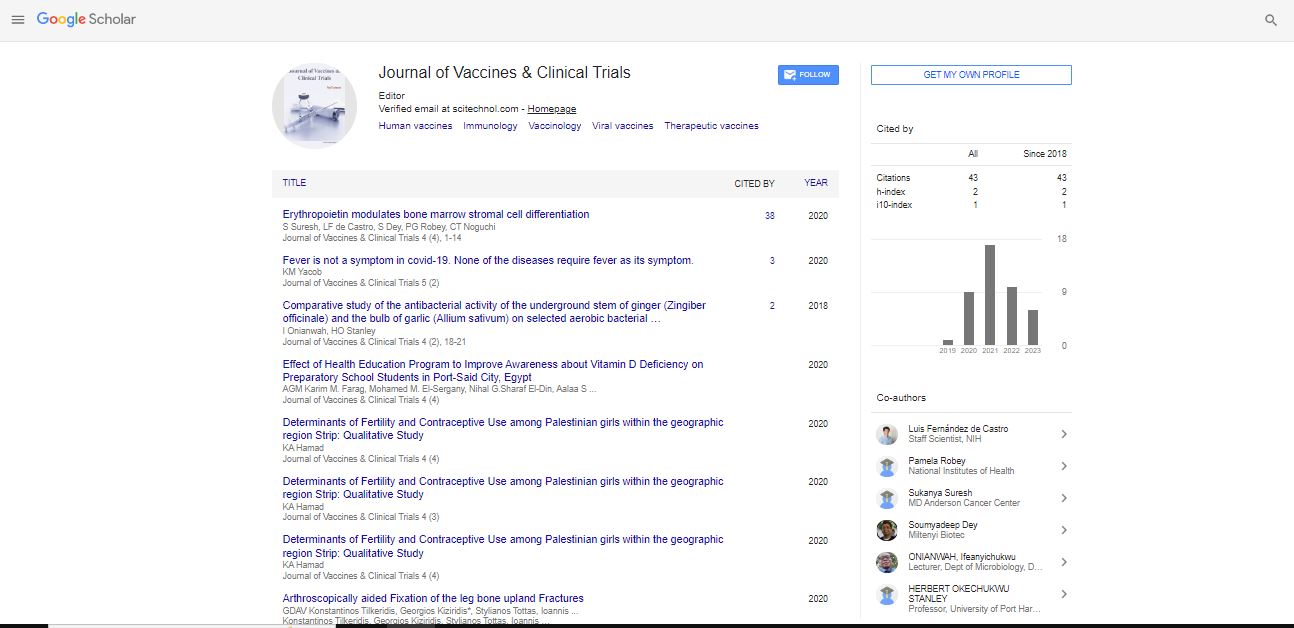Short Communication, Jou Of Vac Cli Tr Vol: 7 Issue: 4
An Overview on Typhoid Fever: Its Causes and Transmission
Addin Almasri*
1Department of Pharmaceutics, Arab International University, Damascus, Syria
*Corresponding Author: Addin Almasri,
Department of Pharmaceutics, Arab
International University, Damascus, Syria
E-mail: almasriaddin909@edu.sy
Received date: 27 November, 2023, Manuscript No. JVCT-24-128365;
Editor assigned date: 30 November, 2023, PreQC No. JVCT-24-128365 (PQ);
Reviewed date: 14 December, 2023, QC No. JVCT-24-128365;
Revised date: 21 December, 2023, Manuscript No. JVCT-24-128365 (R);
Published date: 28 December, 2023 DOI: 10.4172/JVCT.100095
Citation: Almasri A (2023) An Overview on Typhoid Fever: Its Causes and Transmission. Jou of Vac Cli Tr 7:4.
Description
Typhoid fever, caused by the bacterium Salmonella enterica serotype Typhi, has been a persistent global health concern for centuries. This bacterial infection primarily spreads through contaminated food and water, leading to significant morbidity and mortality worldwide, especially in regions with inadequate sanitation and limited access to clean water [1].
People who live or work in or travel to places where typhoid infections are common are at risk of contracting the bacterium. In countries not known for many typhoid fever infections, outbreaks can still happen in areas where sanitation and hygiene are insufficient. The causative agent of typhoid fever, Salmonella typhi, primarily spreads through the consumption of contaminated food or water. Fecal-oral transmission occurs when individuals ingest food or water contaminated with the bacterium, often due to poor sanitation or improper sewage disposal. Additionally, carriers who harbor the bacteria in their gallbladder or intestines without displaying symptoms can unknowingly spread the infection to others [2].
A few weeks after symptoms start, the illness can cause problems in the intestines. People may have:
• Stomach pain
• Very swollen stomach
• An infection caused by gut bacteria spreading throughout the body, called sepsis
In very serious cases, people may:
• Become confused
• Not be able to pay attention to anything around them
• Not be able to react to the world around them
The incubation period for typhoid fever ranges from about 6 to 30 days after exposure. The initial symptoms often mimic those of other common illnesses, including fever, headache, malaise, and muscle aches. As the disease progresses, patients may experience high fever, abdominal pain, constipation or diarrhea, rose-colored spots on the trunk (known as "rose spots"), and in severe cases, complications such as intestinal perforation or hemorrhage [3].
Diagnosing typhoid fever involves a combination of clinical evaluation, patient history, and laboratory tests. Blood cultures to isolate Salmonella typhi from the bloodstream and other tests, such as a bone marrow culture or stool culture, might be conducted to confirm the diagnosis [4].
Antibiotics remain the primary treatment for typhoid fever. However, due to increasing antibiotic resistance, healthcare providers must be cautious in selecting appropriate antibiotics based on local resistance patterns. Supportive care, including adequate hydration and nutrition, is also crucial in managing the symptoms and preventing complications [5].
Preventive measures focus on sanitation, access to clean water, and vaccination. Improving sanitation infrastructure, promoting hygienic practices, and ensuring access to safe drinking water are essential in reducing the transmission of typhoid fever. Vaccines, including injectable and oral formulations, are available and recommended for individuals residing in or traveling to regions where typhoid fever is endemic [6].
Typhoid fever continues to pose a significant global health challenge, particularly in low- and middle-income countries with inadequate sanitation. The burden of this disease extends beyond individual health implications to economic ramifications, as it affects productivity and healthcare costs in affected communities [7,8].
Typhoid fever remains a substantial public health concern, especially in regions with poor sanitation and limited access to healthcare resources. Addressing this issue requires a multifaceted approach, including improved sanitation, access to clean water, vaccination programs, and prudent use of antibiotics to combat rising resistance. Efforts to raise awareness, implement preventive measures, and enhance healthcare infrastructure are crucial in reducing the global burden of typhoid fever [9,10].
References
- Thiravat H, Gabriella U, Supaporn W, Witaya S, Shanop S (2013) Human rabies: Neuropath genesis, diagnosis, and management. Lancet Neurol 12(5): 498-513.
- Jackson AC. Rabies: A medical perspective. 37(2): 569-580.
- Christina L, John DC (2020) Epidemiology of rabies and current US vaccine guidelines. R I Med J (2013) 103: 51-53.
- Kirstyn B, Nardus M (2018) Rabies Virus. Trends Microbiol 26: 886-887.
- Naohide T (2008) Rabies: A preventable but incurable disease. J Infect Chemother 14: 8-14.
- Céline M, Andre C, Bassirou B, Angélique A, Charles B, et al. (2021) Dog rabies control in West and Central Africa: A review. Acta Trop 224: 105459.
- Benjamin NHS, Benjamin Ng WL, Wong SN, Shanthi V (2021) A retrospective analysis of emerging rabies: A neglected tropical disease in Sarawak, Malaysia. J R Coll Physicians Edinb 51(2): 133-139.
- Wei L, Pavan M (2015) Facial dog attack injuries. Indian J Surg 77:55-58.
- Jackson AC. Rabies: A medical perspective. 37(2): 569-580.
- Kirstyn B, Nardus M (2018) Rabies virus. Trends Microbiol 26: 886-887.
 Spanish
Spanish  Chinese
Chinese  Russian
Russian  German
German  French
French  Japanese
Japanese  Portuguese
Portuguese  Hindi
Hindi 